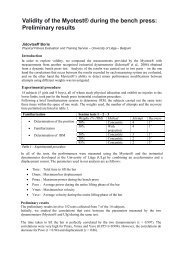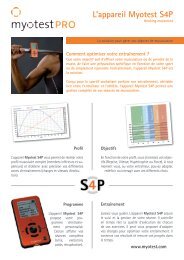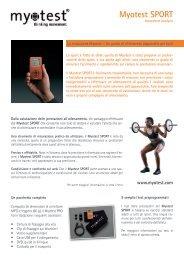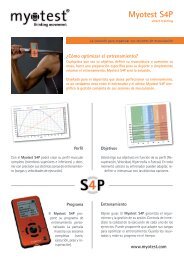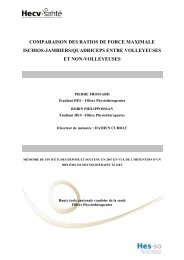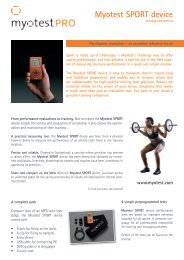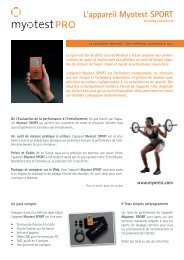Force, Power, and Velocity during Bench Press Movement ... - myotest
Force, Power, and Velocity during Bench Press Movement ... - myotest
Force, Power, and Velocity during Bench Press Movement ... - myotest
You also want an ePaper? Increase the reach of your titles
YUMPU automatically turns print PDFs into web optimized ePapers that Google loves.
<strong>Force</strong>, <strong>Power</strong>, <strong>and</strong> <strong>Velocity</strong> <strong>during</strong><br />
<strong>Bench</strong> <strong>Press</strong> <strong>Movement</strong> on Stable<br />
<strong>and</strong> Unstable Base<br />
Hiroshima University Graduate School<br />
Sentaro Koshida, Yukio Urabe, Koji Miyashita, Kosuke Tanaka,<br />
<strong>and</strong> Aya Kagimori<br />
Department of Sport Rehabilitation
Question about Conventional Strength Training<br />
Conventional strength training may not always<br />
improve the sports performance<br />
Actual Sports <strong>Movement</strong><br />
Strength Training<br />
The strength training may not require stabilizing<br />
the body <strong>during</strong> movements
Importance of Trunk Stability <strong>during</strong> <strong>Movement</strong>s<br />
Trunk muscle activation initiates before upper arm<br />
movements Aruin <strong>and</strong> Latash 1995; Hodge, et al. 1997<br />
Trunk stability is an important component for force<br />
production on upper body in sports performance
Trunk Activity on Unstable Base<br />
Trunk EMG activity was significantlyincreased on unstable<br />
base<br />
Vera-Garcia et al. 2000;<br />
Anderson <strong>and</strong> Behm 2003<br />
Conventional strength training may not improve<br />
neuromuscular control of trunk <strong>during</strong> movements
Applicability of Strength Training on Unstable Base<br />
Isometric force maneuver on unstable condition was<br />
decreased by 60% <strong>during</strong> the chest press<br />
Anderson <strong>and</strong> Behm 2003<br />
Effect of unstable base on force, power, velocity<br />
<strong>during</strong> dynamic upper-body movement is unclear
Objective<br />
To compare force, power, <strong>and</strong> velocity <strong>during</strong><br />
bench press movement between stable <strong>and</strong><br />
unstable base<br />
Clinical Significance<br />
The result will provide us scientific foundation on<br />
applicability of the strength training on unstable<br />
base for the improvement of sports performance
P articipants<br />
20 Competitive male athletes with experience in<br />
resistance training 1year-5years<br />
Age (year)<br />
Height cm<br />
Body Weight kg<br />
1RM kg<br />
Mean ± SD<br />
021.3±01.5<br />
167.7±07.7<br />
075.9±17.5<br />
080.1±21.1<br />
No complaint or pain was reported <strong>during</strong> the testing
Instrumentation<br />
Mono-AxisAccelerometer<br />
Myotest ® , Acceltec, Inc., Switzerl<strong>and</strong><br />
Attached to the center of<br />
the barbell shaft<br />
Sampling rate: 500Hz<br />
Myotest®
Testing Protocol <strong>and</strong> Data Analysis<br />
Test: Three sets of Single <strong>Bench</strong> press movement<br />
at maximum efforts<br />
Starting position:2-3 cm above the chest<br />
Load: 50%RM<br />
Flat BaseB Swiss Ball Base<br />
SB<br />
Statisticalanalysis: Paired-t test was performed to compare<br />
maximum force, power,<strong>and</strong> velocity (p
Results<br />
Maximum force output<br />
N<br />
<br />
800<br />
700<br />
<br />
594.6±150.8<br />
559.9±148.0<br />
600<br />
500<br />
0<br />
400<br />
FB<br />
SB<br />
<br />
N=20<br />
p
Discussion<br />
The maximum force, power, velocity were<br />
significantly decreased on the unstable base<br />
compared to the stable base<br />
Unstable condition negatively affected on the<br />
force performance <strong>during</strong> the dynamic movement
Discussion Cont’<br />
Current study<br />
The maximum force, power, <strong>and</strong> velocity were<br />
decreased by approximately 10%<br />
Previous studies<br />
Isometric force maneuver on unstable condition was<br />
decreased by 60% <strong>during</strong> the chest press<br />
Anderson <strong>and</strong> Behm 2003
Future orientation of the research<br />
<br />
<br />
Trunk stability <strong>and</strong> EMG activity need to be<br />
quantified <strong>during</strong> the movement<br />
Short <strong>and</strong> long term effect of strength training on<br />
unstable surface need to be investigated
Summary<br />
<strong>Force</strong>, power, <strong>and</strong> velocity were measured<br />
<strong>during</strong> bench press movement on stable <strong>and</strong><br />
unstable base<br />
Maximum force, power, <strong>and</strong> velocity were<br />
significantly decreased by less than 10% on the<br />
unstable base compared to the stable base



